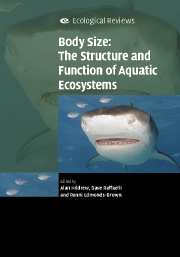Book contents
- Frontmatter
- Contents
- List of contributors
- Preface
- 1 The metabolic theory of ecology and the role of body size in marine and freshwater ecosystems
- 2 Body size and suspension feeding
- 3 Life histories and body size
- 4 Relationship between biomass turnover and body size for stream communities
- 5 Body size in streams: macroinvertebrate community size composition along natural and human-induced environmental gradients
- 6 Body size and predatory interactions in freshwaters: scaling from individuals to communities
- 7 Body size and trophic cascades in lakes
- 8 Body size and scale invariance: multifractals in invertebrate communities
- 9 Body size and biogeography
- 10 By wind, wings or water: body size, dispersal and range size in aquatic invertebrates
- 11 Body size and diversity in marine systems
- 12 Interplay between individual growth and population feedbacks shapes body-size distributions
- 13 The consequences of body size in model microbial ecosystems
- 14 Body size, exploitation and conservation of marine organisms
- 15 How body size mediates the role of animals in nutrient cycling in aquatic ecosystems
- 16 Body sizes in food chains of animal predators and parasites
- 17 Body size in aquatic ecology: important, but not the whole story
- Index
- References
12 - Interplay between individual growth and population feedbacks shapes body-size distributions
Published online by Cambridge University Press: 02 December 2009
- Frontmatter
- Contents
- List of contributors
- Preface
- 1 The metabolic theory of ecology and the role of body size in marine and freshwater ecosystems
- 2 Body size and suspension feeding
- 3 Life histories and body size
- 4 Relationship between biomass turnover and body size for stream communities
- 5 Body size in streams: macroinvertebrate community size composition along natural and human-induced environmental gradients
- 6 Body size and predatory interactions in freshwaters: scaling from individuals to communities
- 7 Body size and trophic cascades in lakes
- 8 Body size and scale invariance: multifractals in invertebrate communities
- 9 Body size and biogeography
- 10 By wind, wings or water: body size, dispersal and range size in aquatic invertebrates
- 11 Body size and diversity in marine systems
- 12 Interplay between individual growth and population feedbacks shapes body-size distributions
- 13 The consequences of body size in model microbial ecosystems
- 14 Body size, exploitation and conservation of marine organisms
- 15 How body size mediates the role of animals in nutrient cycling in aquatic ecosystems
- 16 Body sizes in food chains of animal predators and parasites
- 17 Body size in aquatic ecology: important, but not the whole story
- Index
- References
Summary
Body size in contemporary ecology
Body size and variation in body size have formed the focus of many studies in ecology, ranging from the study of individual performance to large-scale communities and ecosystems (Werner & Gilliam, 1984, Gaston & Lawton, 1988, Werner, 1988, Cohen, Johnson & Carpenter, 2003, Brown et al., 2004, Loeuille & Loreau, 2005). This focus is well-founded given the large variation in body size that exists among organisms from micro-organisms to large mammals (Gaston & Lawton, 1988; Werner, 1988). Body size is also the most important trait that affects the performance of individuals. Basic ecological capacities such as foraging rate and metabolic requirements are close functions of body size (Peters, 1983; Kooijmann, 2000; Brown, et al., 2004) affecting, for example, competitive abilities of differently sized organisms (Wilson, 1975; Persson, 1985; Werner, 1994). Body size strongly influences the diet of consumers with mean prey size, but also the variation in the size of prey eaten, increasing with predator size (Wilson, 1975; Werner & Gilliam, 1984; Cohen et al., 2005; Woodward & Warren, this volume; Humphries, this volume). Furthermore, the risk for an organism being preyed upon is heavily influenced by its own body size as well as the body size of its potential predator (Polis, 1988; Werner, 1988; Claessen, De Roos & Persson, 2000).
Given its influence on basic individual ecological processes, body size has been an important variable in the investigation of larger ecological entities including communities, food webs and ecosystems.
- Type
- Chapter
- Information
- Body Size: The Structure and Function of Aquatic Ecosystems , pp. 225 - 244Publisher: Cambridge University PressPrint publication year: 2007
References
- 10
- Cited by

